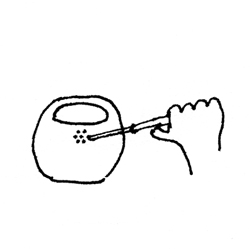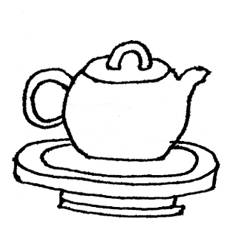This is the famous clay pot of Banpo, a neolithic village dating back to 5000 B.C. If you get tired while carrying it, you just jab the sharp end into the ground and take a break.
This is the famous clay pot of Banpo sitting in our neighbor’s yard. If you get tired of figuring out what to do with the landscaping, you just go archeological.
(See earlier post on why this pot is genius).
Call it clay pot, Donabe, tagine or Römertopf, the idea of cooking with clay is universal. Different countries claim to have endless resources of a particular type of clay that they’ve been excavating for centuries, be it Yixing for teapots or Iga for Donabe.
Working with clay is hard, as I learned from my Yixing teapot master, and pottery has one of the slowest timelines in terms of gratification (photography used to be similar, but has since surged into the “immediate,” but pottery is still far behind others, like architecture or child rearing). What you have on the wheel is definitely not what you get when it dries, much less when you pull it out of the kiln, and let’s not even talk about glazes, which to me seems like painting with invisible ink.
As with many things, understanding clay is complicated, and often technical. A lot of people want to treat clay like it’s a non-geological material, and they just want the best pot from the best clay. Sometimes when I tell the people interested in Yixing teapots that terroir, age and technique does matter, as the material at the bottom of the bag can be different than the stuff at the top, clay being a mixture of dead animals, minerals, etc, they soon move on from their casual interest in teapots to other things like siphon coffee makers and raclette grills.
To ring in the new year we bought the Ibushi Gin Donabe Smoker and though the clay probably comes from the best part of the bag, our technique/timing needs work. Even so, our chubby La Bedaine is so cool it’s hard to screw anything up. What’s missing in the photos is the smell of Sakura wood chips being heated. Wow.
On the bottom we put a piece of opah, the middle had salmon and fennel, and the top had tiger shrimp, fennel and leeks. We should’ve cut the opah into smaller pieces, but it was easy enough to smoke it a second time until it was done. The leeks were smokey but still hard so we just sliced and panfried them in butter, no doubt a technique dating back to 5000 B.C.
















